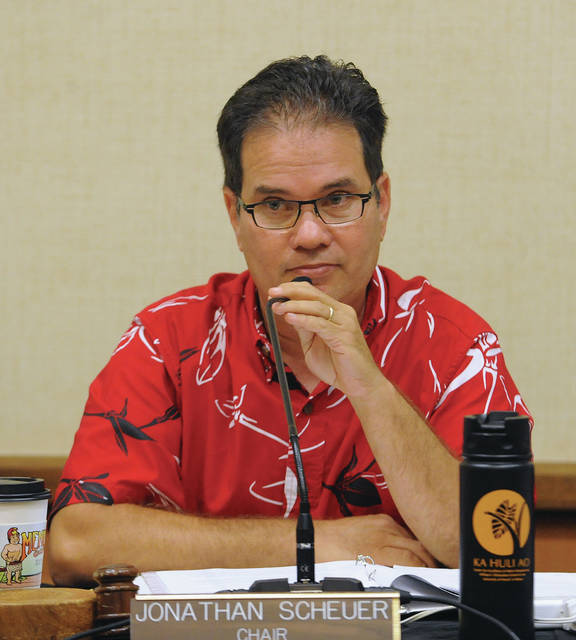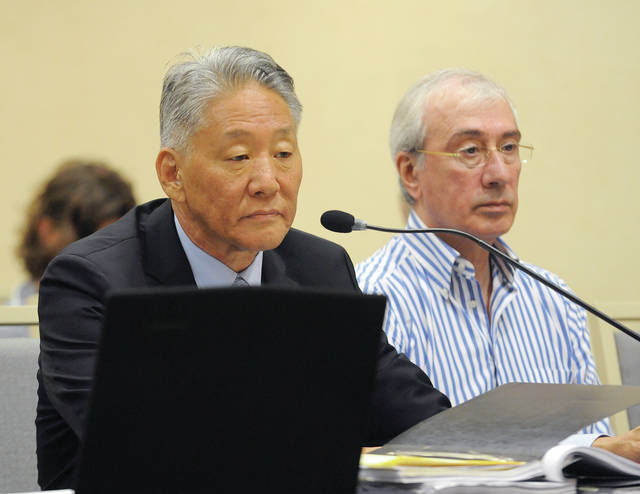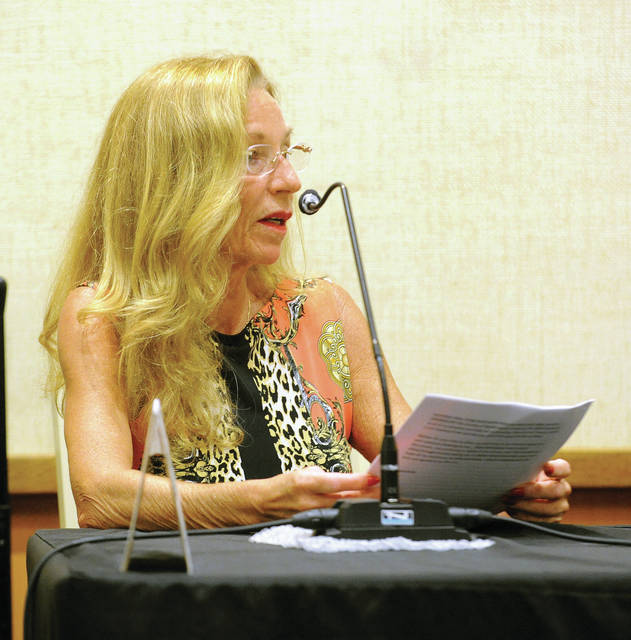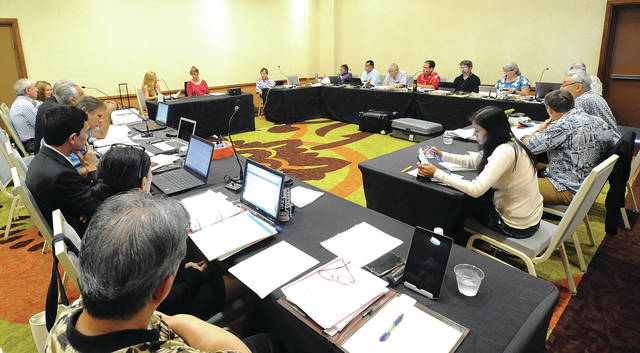Representative behind Waikoloa development commits to following through with project

The Land Use Commission meets to determine Waikoloa Highlands land classification Wednesday at King Kamehameha’s Kona Beach Hotel. (Laura Ruminski/West Hawaii Today)


Waikoloa Highlands representative Steven Lim, left, sits with Valery Grigoryants at a Land Use Commission meeting Wednesday at King Kamehameha’s Kona Beach Hotel. (Laura Ruminski/West Hawaii Today)


KAILUA-KONA — A representative for the developer behind a planned 398-lot residential subdivision in South Kohala repeatedly committed on Wednesday to completing the project that has gone undeveloped for the past decade.
KAILUA-KONA — A representative for the developer behind a planned 398-lot residential subdivision in South Kohala repeatedly committed on Wednesday to completing the project that has gone undeveloped for the past decade.
Arch Ltd. vice president Valery Grigoryants, testifying before the state Land Use Commission at a meeting Wednesday, said he had only last year learned of conditions attached to the 731-acre Waikoloa Highlands project and vowed to keep a close eye on the project going forward.
Arch Ltd. is the 100-percent owner of Vitoil Corp., which itself is the 100-percent owner of Waikoloa Highlands Inc.
“I do not waive any responsibility; I accept full responsibility,” Grigoryants told the commission through an interpreter. “I just regret that we discovered things too late.”
The state Land Use Commission is weighing whether Waikoloa Highlands Inc. should keep the rural district classification it received in 2008 or whether to revert the land to an agricultural classification. The commission in an order to show cause issued in July identified a dozen conditions relating to issues like affordable housing and transportation that the commission suspects the developer of not meeting.
But Grigoryants on Wednesday said the project had been hindered by a former director of the project, Stefan Martirosian, who is now out of the company.
“Me and my brother communicated with him almost every day,” Grigoryants said in response to a question about oversight over the former director. “And so when we communicated, he never told us details of actually what was going on with the project. He would tell us that everything is good, the work was significant, that everything was good.”
Grigoryants said Martirosian was fired from Waikoloa Highlands in 2016, and he only learned of the 2008 decision and order and its associated conditions the following year.
He said the company has appointed a new director, Natalia Batichtcheva, and have also arranged for $45 million in financing to complete the project.
“I promise that I will personally control this project,” he said, “and if the committee makes a favorable decision, I promise that we will complete the project.”
The company has also brought on Hilo consultant Joel LaPinta, who also testified during the hearing.
LaPinta started working with Waikoloa Highlands in June, he said, and that so far about $900,000 worth of engineering work has been completed with another $670,000 worth of additional work still to be done.
He said groundbreaking could potentially come in about 30 months depending on the market.
Asked directly whether the project is feasible, he replied he believed it was.
He also responded to concerns that the land was being held onto for speculative reasons, saying he didn’t believe that to be the case, referencing the amount of work that has already gone into engineering and working with the State Historic Preservation Division on archaeology at the site.
In response to a question from deputy attorney general Dawn Apuna of the Office of Planning, he said there hasn’t been any infrastructure built since the 2008 decision and order.
LaPinta also said in his testimony he thinks the environmental studies and archaeology study were still viable, a response which provoked questions from commission chair Jonathan Likeke Scheuer, who asked LaPinta whether he was aware that the State Historic Preservation Division had revised its rules for archaeological inventory surveys since the study associated with this project was conducted. LaPinta said he was not.
And while LaPinta said that, in his talks with a water company, they believe they can supply water to the project for the first phase, those conversations didn’t encompass the full project.
Regarding the environmental impact statement, Scheuer referenced a 2010 Supreme Court of Hawaii case, Unite Here! Local 5 v. City and County of Honolulu, in which the court determined that an environmental impact statement “cannot be relied on reasonably for an indefinite period of time.”
The final environmental impact statement for Waikoloa Highlands was issued in 2007.



An 11 year old envivinmentai impact report cannot be relied on
for sure. The person in charge certainly seemed not in charge if he didnt know what questions needed to be asked of his former director who appeared incompetent to know what was Needed.
Why not? The entire island has only added about 15,000 people since then and Waikoloa looks essentially the same.
I think everyone is for a good environment but a part of that environment is housing that we can afford. A big part of the affordable housing equation is increasing the supply and reducing soft costs. Another environmental impact study and a new archaeology study simply adds to the costs and delays the supply coming on line.
The environmental impact will show transportation issues for residents need to be solved by the developer, building in that location. Far Away from hospitals etc. Otherwise it puts the burden on you the tax payer. Is that what you want? Big companies in the mainland provide buses for employees at the companies expence. Its time for Hawaii to consider this for sub division developers responsibility
Also a percentage of units need to be designed small and built for low incomes workers so the dont have more people commuting from Hilo….
I am glad we can engage in a civil discussion. Here is the problem as I see it.. Currently Hawaii is raising the percentage of tax on everything Income Tax, Property Tax, GET, TAT, Gas Tax so “we” are clearly already on the hook. In addition there does not appear to be any end in sight. Development is actually the best way to grow the tax base in a place like Hawaii. New development will hopefully stop the % tax increases which are devastating in the long run. Development substantially increases economic activity so revenue from GET and Income tax increase, then after paying the taxes the person that moves into the unit continues to pay property tax and if the population grows we get federal infrastructure funds to build new roads. If done well this is a very virtuous cycle.
To your point if having a new environmental impact statement makes a better development by creating the right type of units and being in harmony with the community, I would agree wholeheartedly. The problem with these environmental study process is that it often turns into a how to stop the development effort and NIBY (not in my back yard) efforts.
I DON’T THINK this DELOPEMENT is in ANYONES Back YARD
IS IT? Thanks for your input .
Once the powers that be get contol and they make them jump through all the hoops again, this project will no longer support incorporating affordable housing, not in your wildest dreams. This project was put on hold in 2008, you do remember 08, I know I do, layed off and on unemployment for over a year. They have sat on this waiting for better times and it has arrived and want things to stay the same. The powers that be now have them over a barrel and the law suit locals do too. This a gold mine for all that power that BE.
Yes I remember 2008. When construction is happening everyone seems to do well, and when it is not times are particularly tough for those of us who make things for a living.
Regarding the powers that be.. Today it seems like houses are 80% politics and just 20% house and that just seems crazy to me.
what a joke